Market
Forget the Old Masters, It’s All About the Old Monsters in the Booming Market for Dinosaur Fossils
We can thank Steven Spielberg for the surging market, but scientists are not happy about it.
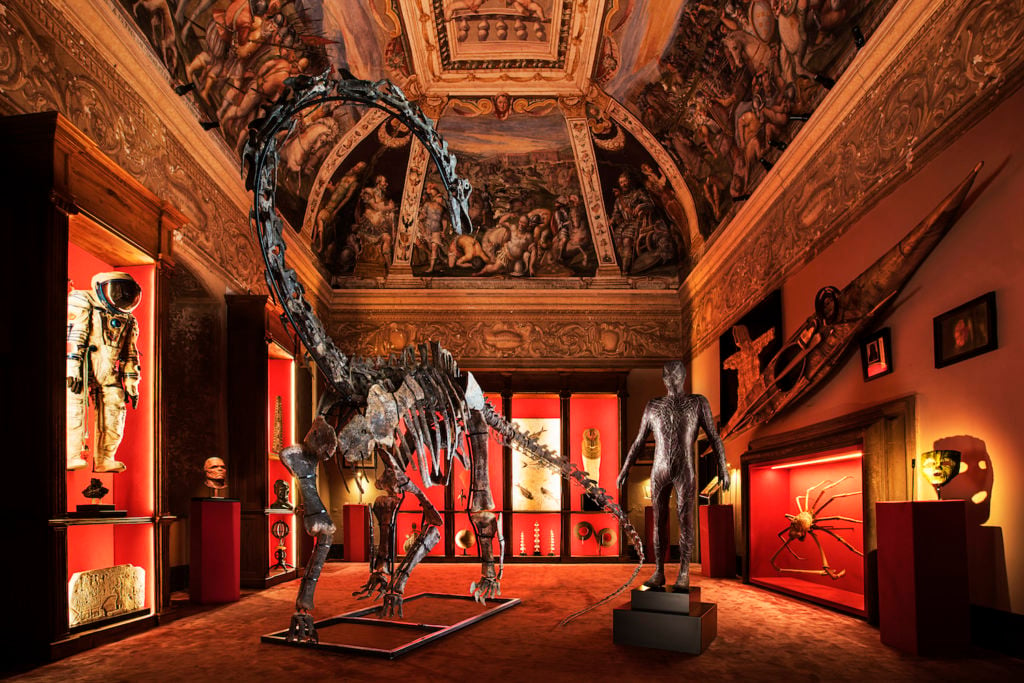
We can thank Steven Spielberg for the surging market, but scientists are not happy about it.

When building their prestigious collections, most collectors don’t think of adding a Tyrannosaurus Rex. But that may soon change.
Around the world, there is a growing appetite—and expanding market—for fossils of the long-dead beasts that once roamed our planet. Art fairs are beginning to put relics on view. Celebrities like Leonardo DiCaprio, Nicolas Cage, and Russell Crowe are buying them up. And auction houses are becoming increasingly aware of the show-stopping value of having an extra large dinosaur on display.
Last June, the Parisian auction house Aguttes did just that, and held a rather unusual sale inside the Eiffel Tower with only one lot: a 8.7 meter (29 foot) dinosaur of a yet-to-be identified species. The skeleton ended up going for €2 million ($2.3 million).
Elsewhere, power players Christie’s and Sotheby’s are also offering incredible rarities from the depths of prehistory, and private dealers are offering their clients awe-inducing monsters and other relics of natural history.
So, what’s behind the surge?
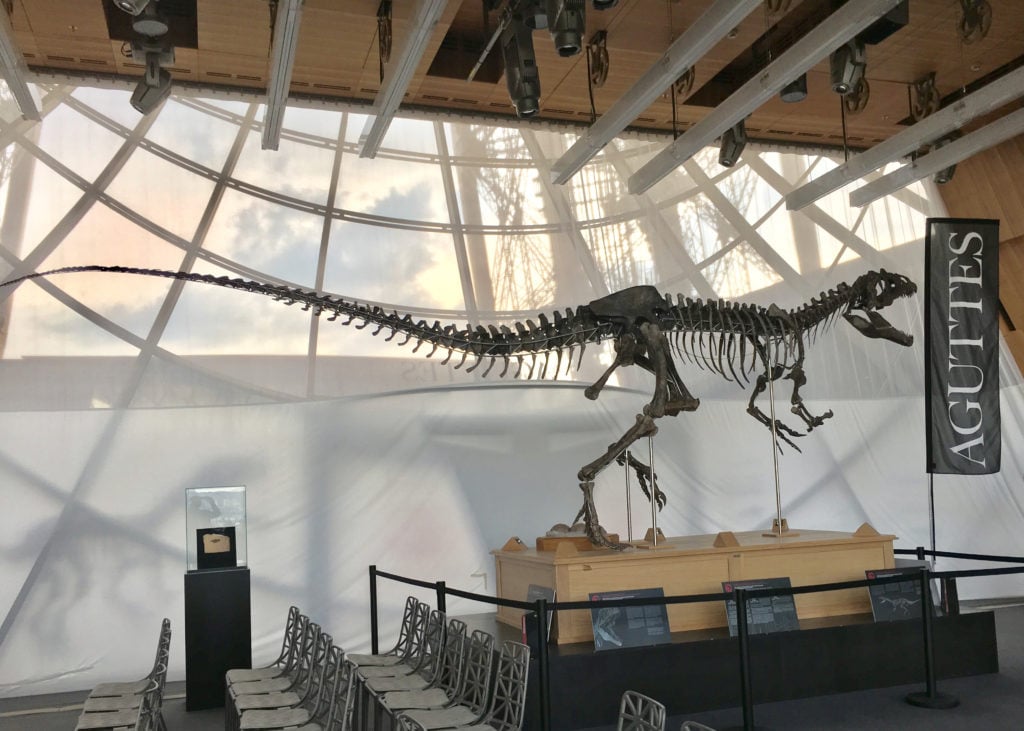
Last June, Aguttes sold this dinosaur skeleton in a unique sale at the Eiffel Tower. Courtesy Aguttes.
“Owning a dinosaur has become a trend. Their skeletons are effectively regarded as design objects,” says dealer Luca Cableri, who sells dinosaur fossils among other curiosities through his gallery, Theatrum Mundi, in Arezzo, Italy. “But few people know that a dinosaur is a work of art. Few people know the work of paleontologists, artisans, designers, and academics necessary to rebuild and restore it.” His gallery even has a paleontologist on staff, pictured donning a safari hat.
Bit by bit, dinosaurs are appearing at art fairs. Theatrum Mundi was one of four galleries at the most recent Brussels Art Fair (BRAFA) to have pieces of natural history on offer. Last year at Art Miami, a satellite of Art Basel, a special project called “DeXtinction” was organized by two mining companies. Page Six reported that Leonardo DiCaprio was at the booth eyeing a $2.5 million dollar, 120 million year-old mother and juvenile Allosaurus (though another source rebuffed the claim).
Fossils are becoming a coveted home decor object, says Eric Mickeler, a fossil specialist who helped Aguttes organize the dinosaur sale at the Eiffel Tower. And though most fossils are less expensive than the priciest unique works of contemporary art, there are only a finite number of them in existence, and significant new discoveries, like an intact skeleton, are relatively rare.

Dinosaur skeleton from Aguttes sale at the Eiffel Tower last June. Courtesy Aguttes.
Like the art market with its darlings (Jeff Koons, Gerhard Richter), the dinosaur market also has its top “brands,” says James Hyslop, head of the department of scientific instruments, globes, and natural history at Christie’s.
The Velociraptor—characterized as a wily thug in the blockbuster Jurassic Park movies—enjoys more demand than many of its fellow reptiles. And at the top of chain, there is, of course, the mighty T.Rex skeleton, which is a true collector’s crown jewel and the most desirable of all species, according to Cableri. It can cost anywhere between €3 million and €10 million.
At the more affordable end of the spectrum, an Allosaurus can go for anywhere between €1 million and €1.5 million, while the price tag for a Triceratops’s skull is somewhere around the €150,000 to €350,000 mark. If you want to buy a medium-sized Diplodocus—a herbivore—you’re looking at €500,000 to €1 million.
In short, carnivores have a hotter market. But the real selling points are quality and rarity, which means a thriving market for other extinct species, too.
Last year, when Christie’s sold an intact elephant bird egg for £100,000 ($128,200), the house doubled the item’s presale estimate of £50,000 ($64,100). Hyslop says that about five to ten years ago, similar objects were going for around £20,000 ($25,640) to £30,000 ($38,460).
“It’s a very sculptural and beautiful form, so it’s something that appeals to collectors from contemporary art to antiquities to tribal arts, in additional to natural history collectors,” Hyslop says of the egg. “Megalodon teeth are hugely popular with collectors of tribal arts, and I suspect that is just due to the nature and shape of the object.” Megalodon were 25-ton, 34-foot-long sharks that went extinct about 2.6 million years ago.
So just like art, natural history has its mega-hits—and there are surely more great objects to surface to the market.
“I think a lot of people are surprised to learn that there are still true masterpieces of natural history readily available,” Hyslop says. “Some quarries are still being actively excavated, so there is, in a sense, a primary market for these objects, as well as a secondary market.”
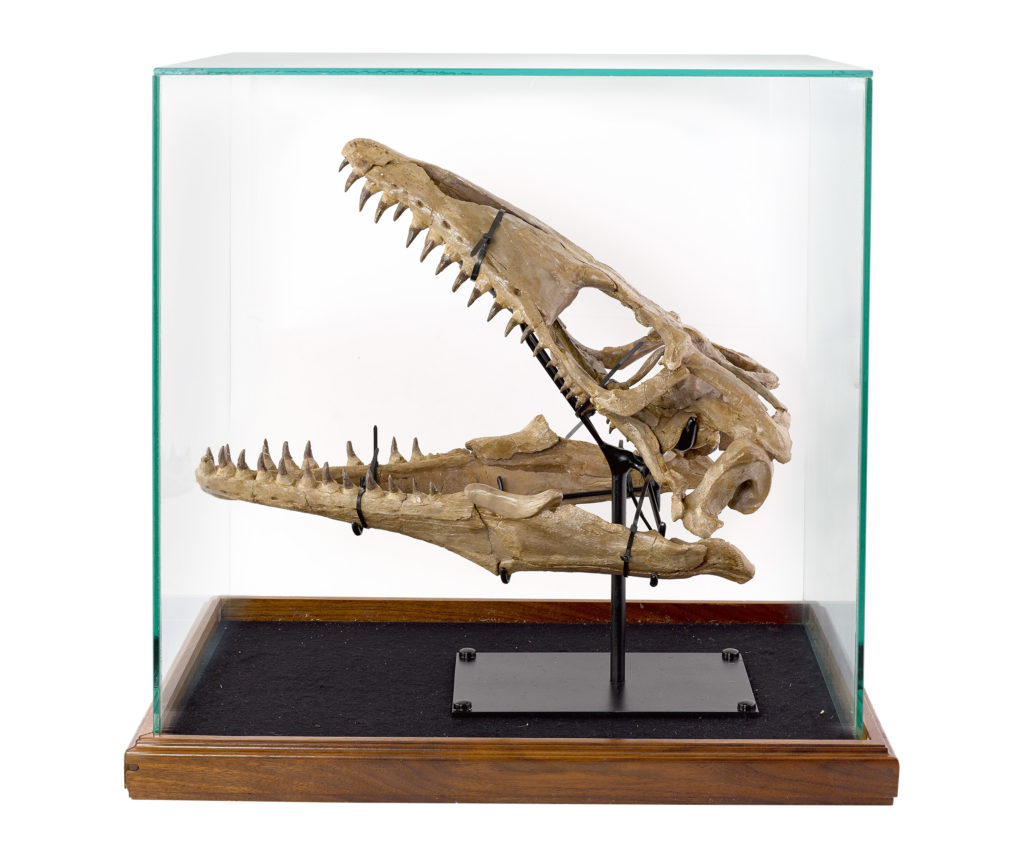
The Mosasaur Skull from Russell Crow’s “Art of Divorce” sale. Courtesy of Sotheby’s Australia.
To find the contemporary roots of this rising market, we have to look to Hollywood. Experts agree that Steven Spielberg’s 1993 film Jurassic Park sparked a huge interest. In 1997, just months after the film’s sequel, The Lost World, was released, the dinosaur craze reached a fever pitch when 40 foot-long Tyrannosaurus Rex named Sue was sold at Sotheby’s for a record-breaking $8.36 million to the Field Museum in Chicago. The record remains unbeaten.
“[Jurassic Park] reignited the public’s fascination with dinosaurs,” Hyslop says. And for the market, it was a decisive event. “There was then a moment where people realized, ‘Hey, you can actually buy these things for less than a Picasso.'”
“A seller could have become a millionaire then just by selling dinosaur teeth, the demand was so strong,” says Mickeler, the French fossil specialist.
DiCaprio certainly took notice. The Oscar-winner, who is also an avid fossil collector, once got into a bidding war with Nicholas Cage over a $276,000 dinosaur skull. (Cage won, but the skull turned out to have been smuggled out of Mongolia, and so the actor agreed to return it to its home country.)
DiCaprio popped up again when Russell Crowe auctioned off a Mosasaur skull that listed DiCaprio in the provenance. The skull, which sold as part of Crowe’s “art of divorce” sale, went to DiCaprio for $79,300 with buyer’s premium.
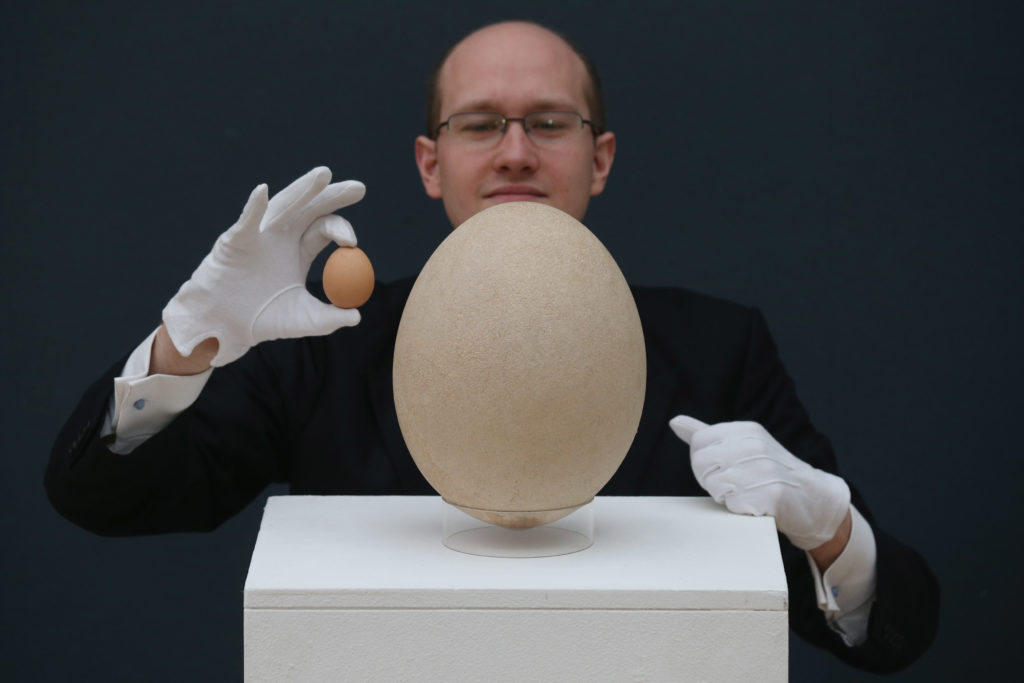
James Hyslop examines a complete sub-fossilised elephant bird egg at Christie’s. Photo: Oli Scarff/Getty Images.
Dino-mania isn’t confined to the Hollywood Hills. Hyslop says interest is growing worldwide. “We have sold fossils, minerals, and meteorites in every continent except Antarctica,” he says.
Nor is the phenomenon brand new. “If you go back historically and look at the early 20th-century market, or Victorian England, the prices for the top dinosaur specimens were pretty close, if not on the par, with some of the top paintings,” Hyslop says. The gap is very wide now, but fossils are nevertheless on the rise.
Today, like art market insiders, fossil dealers and auctioneers are looking east. “The future of the market is certainly represented by Asian countries, where we have already sold several specimens, and especially by China,” Cableri from Theatrum Mundi says. (Curiously, China’s northern neighbor, Mongolia, which is a fertile ground for ancient bones, is one of several countries that bars the commercialization of fossils.)
Even then, Cableri says, there are no “typical” customers. Although he has sold relics to several castle owners in France who were looking to spruce up their homes and attract more visitors, he says he has never sold more than one sample to the same client.
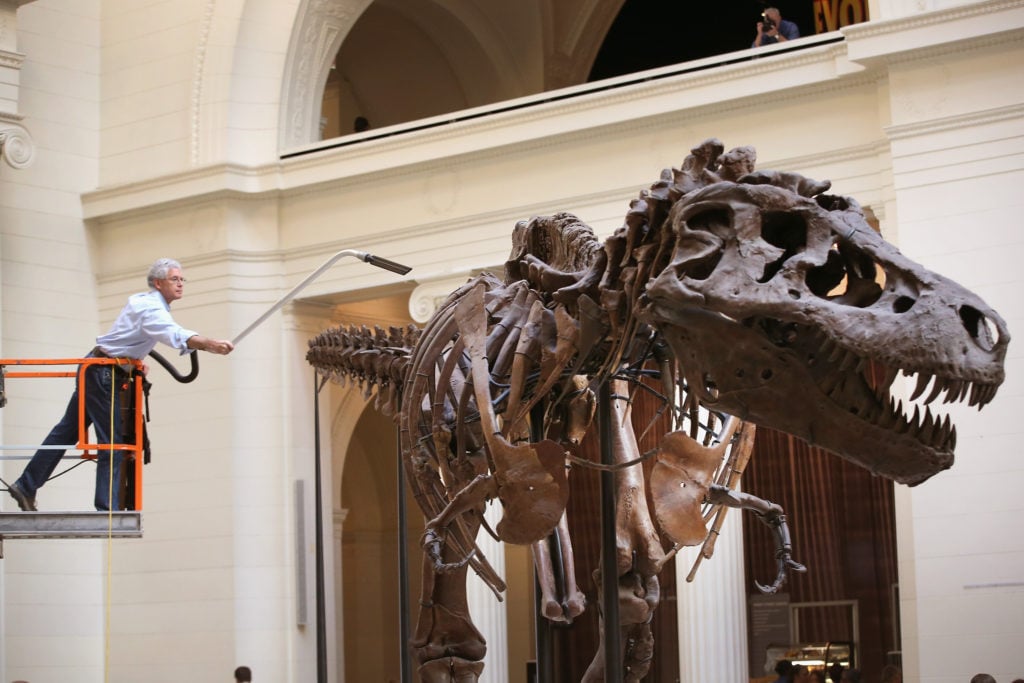
Geologist Bill Simpson cleans Sue at the Field Museum in Chicago. Photo: Scott Olson/Getty Images.
But as the market roars and collectors rush to snap up the best gems, it may become more difficult to keep these prized pieces of natural history on public view—and within reach of scientists.
Last May, ahead of Agutte’s dinosaur sale, the Society of Vertebrate Paleontology, which represents more than 2,200 international paleontologists, wrote to the auction house asking it to cancel the sale.
“We urge you to reconsider the sale of this scientifically important skeleton,” they wrote. “Scientifically important vertebrate fossils are part of our collective natural heritage and deserve to be held in public trust.”
But Eric Mickeler, who led the sale, says dinosaur fossils are akin to other gems. “It is a mining product resulting from a fortuitous meeting, similar to the discovery of an exceptional diamond,” he says.
Museums, in the end, may feel the pinch—an all too common story, and one with a long history. When the Field Museum bought its T. Rex in 1997, it pulled together $8.36 million with funds from the McDonald’s Corporation, Ronald McDonald House Charities, and the Walt Disney World Resort, among others.
Will costs continue to rise? Mickeler thinks so. “At a certain point, supply will not be able to satisfy demand and prices will explode.”